Using your home oven properly for baking macarons can help to avoid hollow, lopsided, browned or cracked shells. This post will go over different ways to set your home oven for baking colorful macarons.
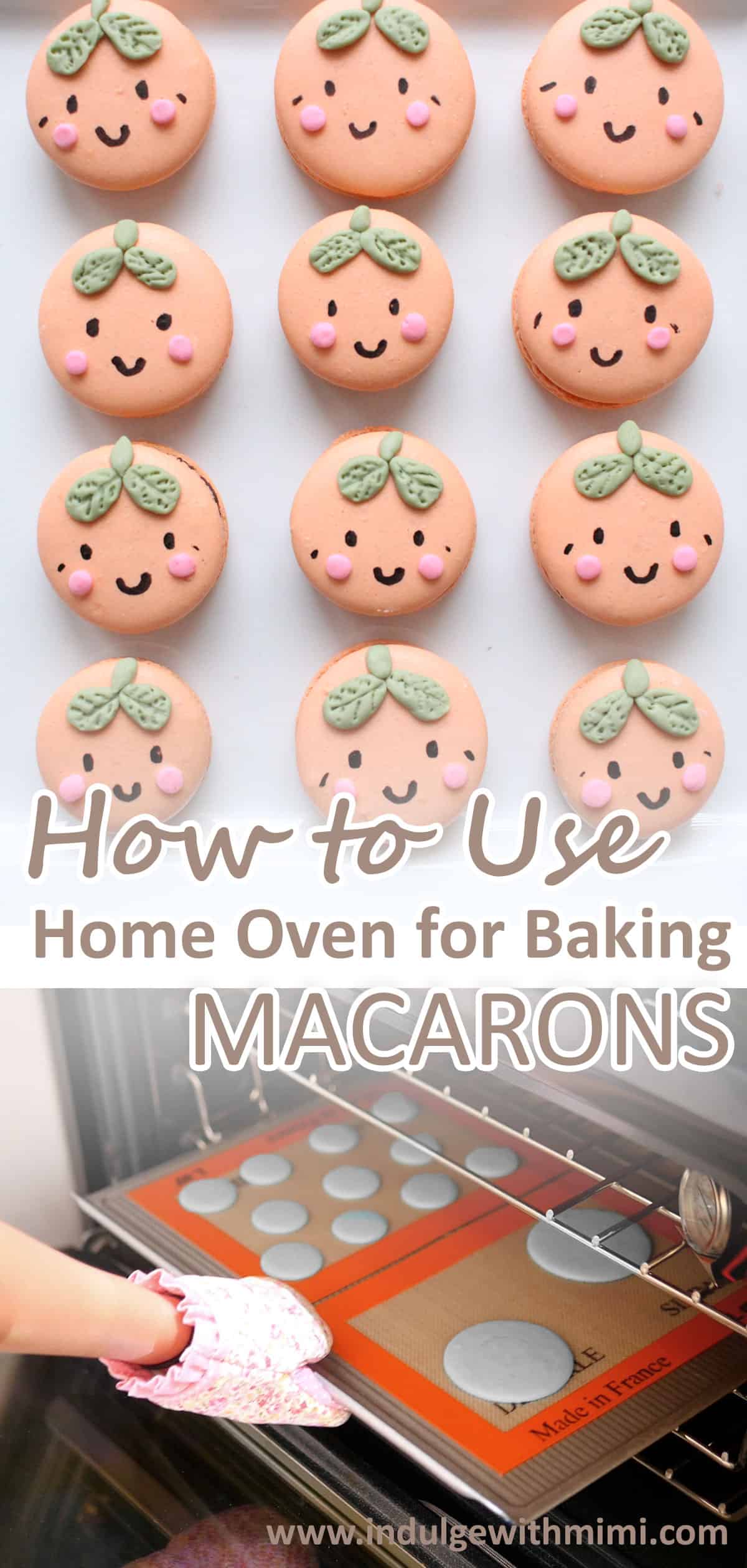
Jump to:
I wrote this post on correctly using your home oven for baking macarons because I found that there wasn't much information about how to use your home oven properly when baking macarons. Unlike spacious and sturdy commercial grade ovens with even heat distribution, home ovens can be temperamental and seem to need a lot of coddling.
For any home baker, it's very important to know their own oven well in order to achieve success with any recipe, even my Best Macaron Recipe will only get you so far in achieving perfect macarons if you don't know how to adjust your oven properly for baking macarons. You will need to experiment under different baking conditions like rack position, temperature and bake time to find the optimal conditions for successful baking. When you learn to trust your oven, it will love you back ♥
When I started making macarons, I was more concerned about feet development and just making sure that the macarons actually looked like macarons. Needless to say, I was not too picky back then. But as I baked more of them, I realized that all the faults like hollow shells, crispy over baked bodies etc. would actually manifest itself in its outer appearance. In other words, you are essentially showing the world all your macaron's faults just by its visual presentation. I started to demand more perfection from these little sweet treats.
Even when you follow a macaron recipe religiously, you can still end up with ugly or underdeveloped macarons simply because you used your oven incorrectly (READ: Macaron Troubleshooting Guide). Almost all the recipes I've come across only instructs to bake at a certain time and temperature on the middle rack. It drove me crazy when I ended up with overly brown or under cooked macarons. It led me to experiment with my oven in order to get my macarons just right.
Average Baking Time & Temperature for Macarons
I'm not claiming to have the exact solution for you because all ovens are different. Every baker should know their own oven well. This post highlights the different ways to adjust your own oven to perfect the baking process. You may need to use a combination of these adjustments to achieve the results you want depending on your own situation.
All of the scenarios below are in reference to the average baking time, temperature and rack position of the two methods below:
♥ FRENCH Method: 320 F for 12-14 minutes on the middle rack ♥
♥ ITALIAN Method: 260 F for 20-22 minutes on the middle rack ♥
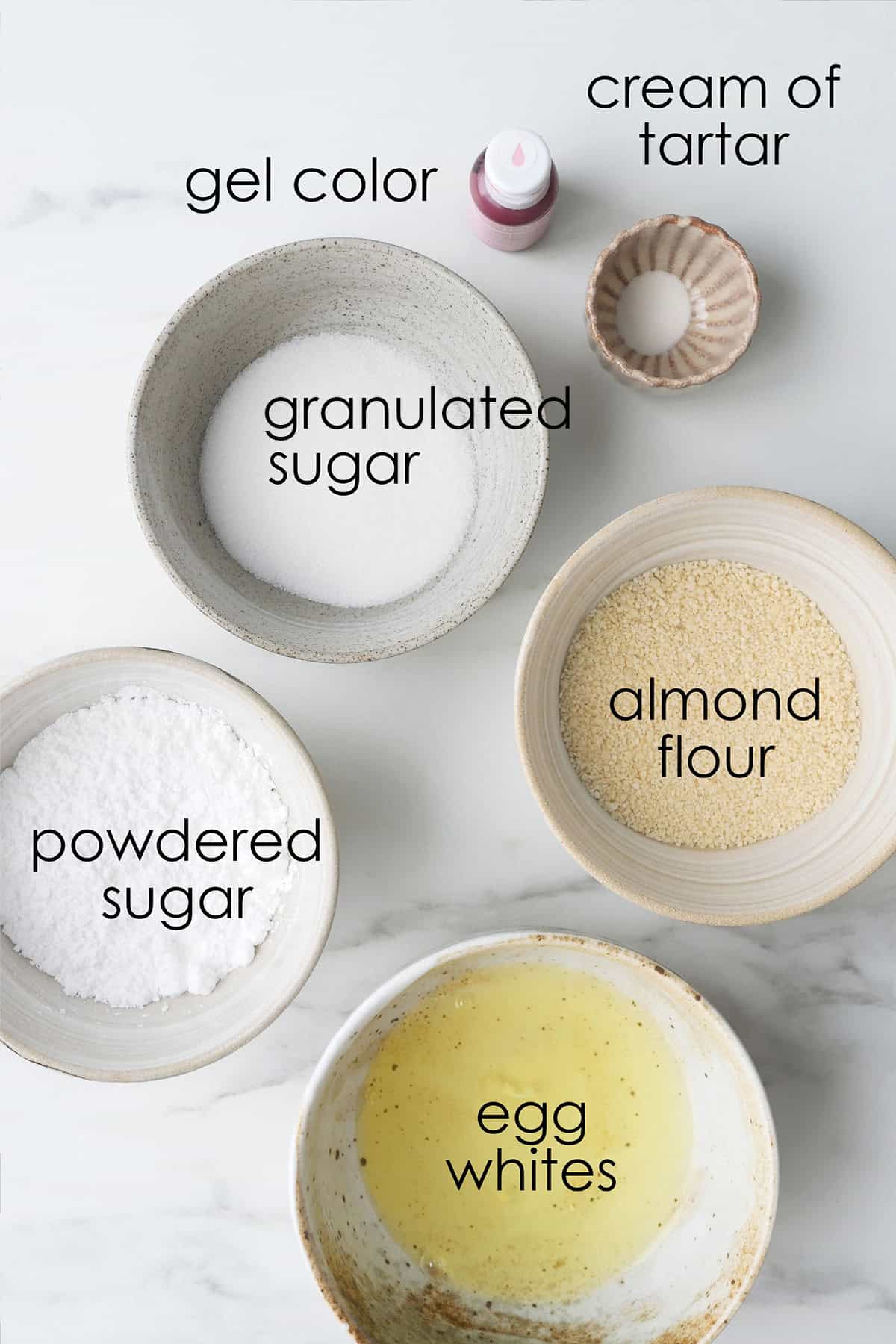

Oven Adjustment Methods
Baking Time and Temperature
Macarons can be over baked/under baked and feet development can be overdeveloped/underdeveloped if the baking time or temperature is not well aligned. For over baked shells or over developed feet, the temperature is probably too high causing it to bake too quickly. You will also find that feet which develop quickly and outwards are also victims of over folding and overly hot oven temperatures. The high heat forces the feet to develop much too quickly and it has nowhere to go except up and out. On the other hand, under baked shells and under developed feet (not a lack of feet due to wrong folding techniques, just underdeveloped), cannot fully reach their full potential when the oven temperature is not high enough.
Learn to adjust the temperatures in your oven. To compensate for adjusted temperatures, you will also need to readjust the baking time and vice versa. For temperature increases, baking time should be decreased. For temperature decreases, baking time should be increased. However, baking at lower temperatures may sometimes result in an undercooked shell and baking at higher temperatures may cause shells to brown. If that is the case, try adjusting the rack position as outlined in the next section.
Baking Time and Temperature Relationship
Macaron Baking Time and Temperature Relationship
↑ Increase temperature - ↓ decrease time
↓ Decrease temperature - ↑ increase time
As a starting point, for every 25 F increase or decrease, compensate with a 2-3 minutes change in baking time in the inverse direction.
Some Recommended Baking Temperature and Times
350 F for 10 minutes - suitable for spacious large ovens
325 F for 12-14 minutes - standard starting point for my recipe
300 F for 16-18 minutes
275 F for 18-20 minutes - suitable for smaller ovens with small compartments
These temperatures are for conventional ovens without convection setting. Usually, it is recommended to decrease the temperature by 25 F when using the convection setting.
Rack Position
The middle rack is often the "default" position in any oven. It's ideal for most foods since it allows the hot air to circulate evenly around the food, resulting in balanced heat distribution. Most recipes recommend that you bake your macarons on the middle shelf. However, you may need to adjust this depending on where your heat source is coming from and your own individual problems.
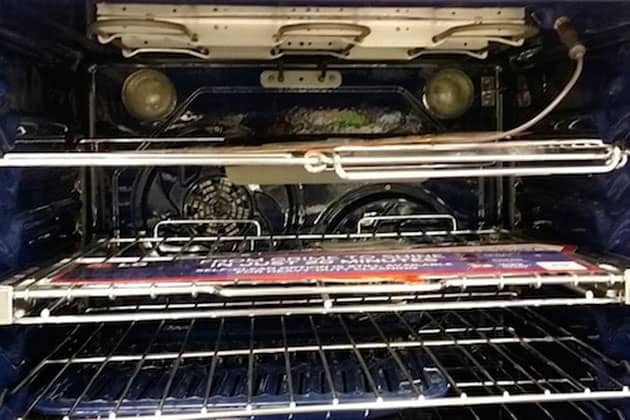
Browning of shell top due to broiler's heat source from the TOP of the oven without convection fan: If the tops of your macarons are browning too fast before the centre is fully cooked, try moving your macarons to a lower rack until the feets develop. Then, place an empty tray on the rack above the shells to shield them from the heat.
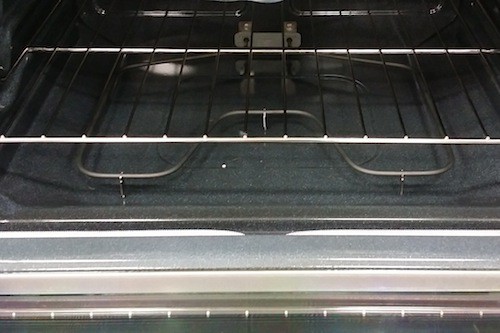
Shells browning on bottom due to heat source from the exposed bake element at the BOTTOM of the oven without convection fan: If your macarons are browning on the bottom before the centre is fully cooked, try moving the macarons to a higher rack. If that alone doesn't help, you can try adding an extra tray immediately below the current tray to prevent it from heating up too quickly.
Convection vs. True Convection
A regular convection oven features a fan which helps to distributes the air around the oven. A "true convection" (a.k.a European convection or third-element convection) utilizes an additional heating element behind the fan to blow heated air to your dish. This method produces more even heat distribution and better baking results.
Using the convection fan
I have become a recent convert to the convection fan since I have found that the temperature remains consistent throughout the baking process with only a 5 degree variance. The fan helps to distribute heat more evenly throughout the oven cavity so you may even be able to bake several trays at once. The heat reaching your macarons may be increased and you may need to decrease the temperature or baking time. As a starting point, it is usually recommended to decrease the temperature by 25 F when using the convection setting.
On the flip side, some bakers may find that their convection fan is a little too strong and causes the macaron shells to become lopsided. You can consider turning on convection cooking during the latter part of the baking period since your shells will already be stronger at that point than when they were wet. If that doesn't help, you may need to skip using the fan altogether.
Having said all that, a convection fan is not necessary when using your home oven for baking macarons. It is a nice added bonus to keep the heat distributing evenly and consistently. You can still achieve this by using other baking tweaks and the proper heat conducting kitchen tools which will be outlined below.
Hot-Preheat Method
If you're still having trouble using a slow and consistent temperature method, try the hot-preheat method. Increase the oven temperature 50 degrees more than the usual baking temperature during the preheat. Once it has reached that temperature and you're ready to bake, turn it down to the regular baking temperature once you place your trays inside. You will need to compensate for this increase in temperature by baking it a shorter amount of time.
This method allows your shells to develop feet from the exposure to the initial high heat but lets them finish off at a lower temperature to avoid browning and over baking. You'll need to be careful of this though as home ovens can cycle hot and cold before it ever reaches your desired temperature so adjusting the temperature mid-way in the baking process may not really change the temperature as you'd hope it would. Read this post on finding a consistent oven temperature.
Reduce Oven Moisture
In Pierre Herme's Macarons book, he advises to open the oven door near the end of the baking time after the feet have developed to let out the steam. Personally, I have never had to do this. I rarely open the oven or turn my trays because I prefer to keep the oven door closed so the heat remains consistent but if this is an area of concern for you, you can also keep the oven door ajar for the whole or for a duration of the baking time by propping a wooden spoon in between the door. You will need to compensate for the loss in heat by increasing the oven temperature.

Good Oven Practices for Baking Macarons
Always Pre-Heat Oven and Use an Oven Thermometer
Always Pre-heat your oven to the correct temperature before placing your trays inside. Place an external oven thermometer inside the oven to ensure that the temperature is correct. Many bakers assume that their ovens are at the correct temperature when in fact, it has increased or decreased during the baking process without their knowledge.
You don't need a fancy thermometer, just a simple hanging one like this one will do. I like that it is small and saves space because it can be hooked on the upper tray. Did you know that the temperature during the initial period of pre-heating is the most unstable? Read my other post on Maintaining a Consistent Oven Temperature.
Identify Hot Spots in Your Oven:
If you are getting uneven results from the same tray of macarons - some are browner than others or some are under baked - you may be facing an issue of hot spots in your oven. You'll need to avoid placing macarons in those areas and rotate your tray throughout the baking time to achieve more even heat distribution.
A great way to identify the hot spots in your oven is to bake several slices of white bread on a tray until it turns brown. You can then see if they have all browned at the same pace or if some are browner than the others.
Bake One Batch at a Time:
I do not recommend baking several trays at once until you have already found the optimal conditions in your oven to bake a perfect batch. Until then, it would be difficult for you to determine why your macarons did not bake successfully. When you bake several batches at once in a small home oven, sometimes heat cannot be evenly distributed to all the shells at the same time. Also, if you are baking on different racks, you would be forcing your macarons to be closer to or further away from a heat source than you'd like. Although not advised for new macaron bakers, if baking several batches at once, try to: alternate the trays midway into the baking time or bake 2 trays on the same rack instead of on different racks. If you have a true convection oven, baking several trays may be easier with the convection setting.
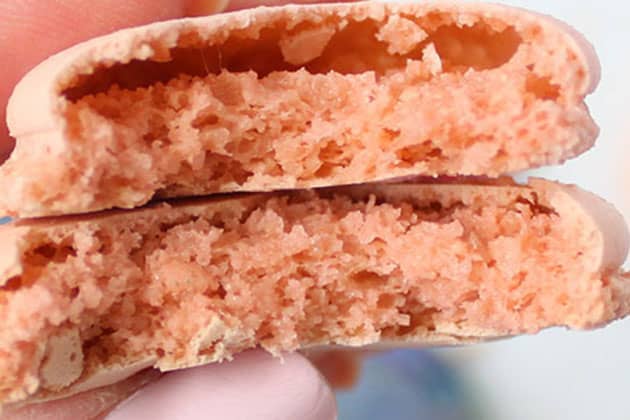
Avoid Hollows
Hollow macaron shells are a result of a combination of poor batter preparation and not enough heat distribution during baking. To combat the latter, use good heat conducting equipment and increase the temperature or baking time.
Check that your baking pan is conducting enough heat to your macaron shells to help it rise. I like using these rimless aluminized steel ones because it conducts heat evenly and allows for good airflow. It is also very sturdy and doesn't buckle easily, preventing lopsided macarons.
A way to encourage heat transfer from the pan to the macarons is to use parchment paper or Teflon sheets instead of silicone mats. I like silicone mats because they keep the macaron shapes from spreading. I only use Silpat branded ones because they are guaranteed to be made from food-grade materials and they conduct heat well.
Lastly, to maintain a consistent temperature inside the oven, try keeping a pizza stone inside the oven on a lower rack from the macarons. I wrote a whole guide on How to Prevent Hollow Macarons if you're interested in reading more about this.
Summary of Macaron Troubleshoots Due to Oven Conditions
(Complete macaron troubleshooting here):
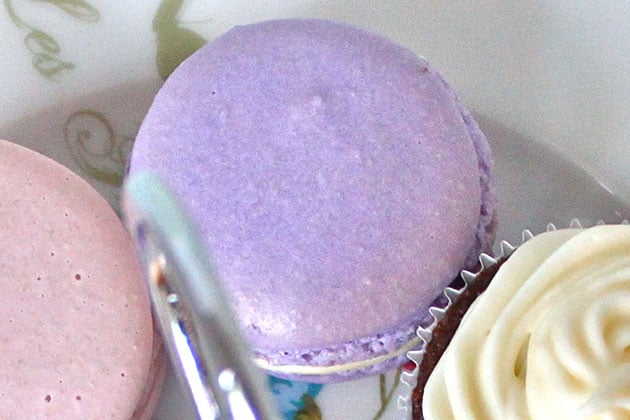
• Shell top is browning:
- move further away from heat source
- decrease temperature, increase time
- shield macarons with empty tray on rack above
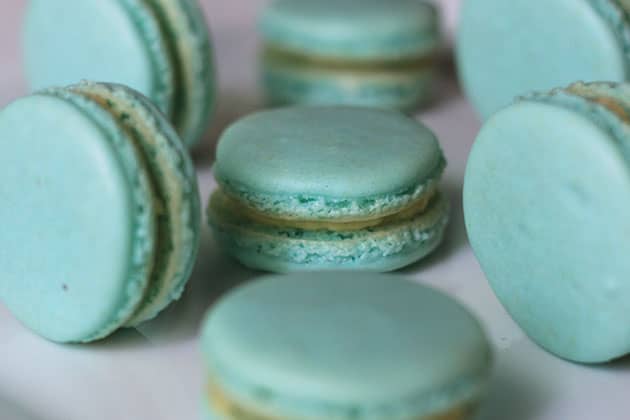
• Shell bottom is browning:
- move further away from heat source
- decrease temperature, increase time
- add double pan on bottom
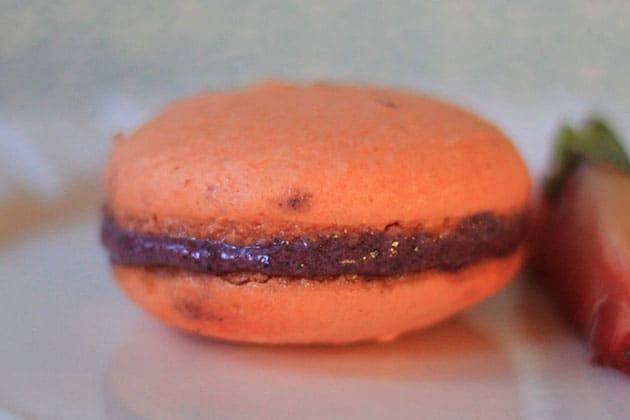
• Shell is undercooked or feet is under-developed:
- move closer to heat source
- increase baking time
- increase temperature
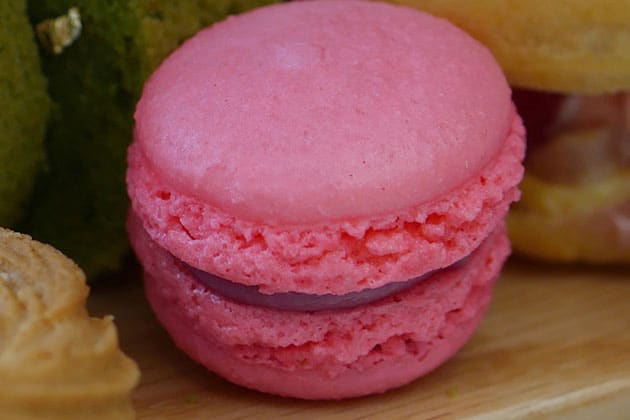
• Shell is overcooked/dry or feet is over-developed:
- let macaron mature 24 hours or more after filling
- brush same flavoured syrup or milk on bottom of shells
- next time, turn down heat or move away from heat source
- stop whipping egg whites once it reaches stiff peaks
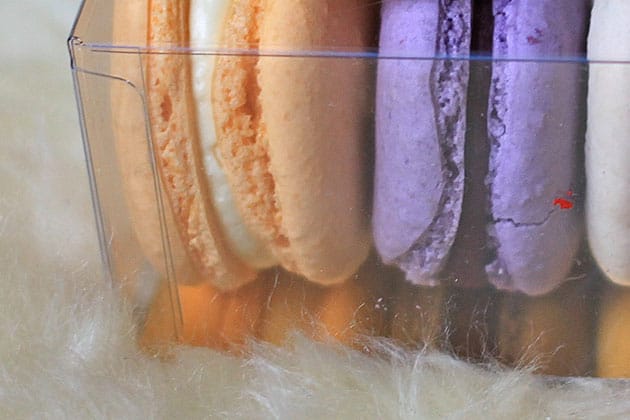
• Shell is lopsided:
- avoid using convection fan if thats the culprit
- avoid using fans the blow directly onto macarons while waiting for skin to develop
-use the range hood fan instead to dry out piped macarons
- consider using a silpat mat instead of parchment paper
- incorrect piping techniques
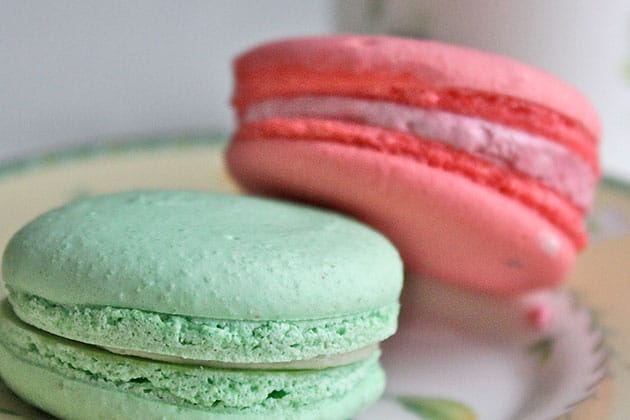
• Inconsistency in the same batch:
- identify hot spots in your oven
- bake only one tray at a time until you find the optimal baking time/temperature
- for trays baked on different racks, alternate the trays midway into the baking time
- ensure batter is fully incorporated before piping
I hope this post on how to correctly use your home oven for baking macarons. Let me know how yours went.
Happy Baking to You!
XOXO, Mimi
Note: This post was originally published on October 1st, 2014.

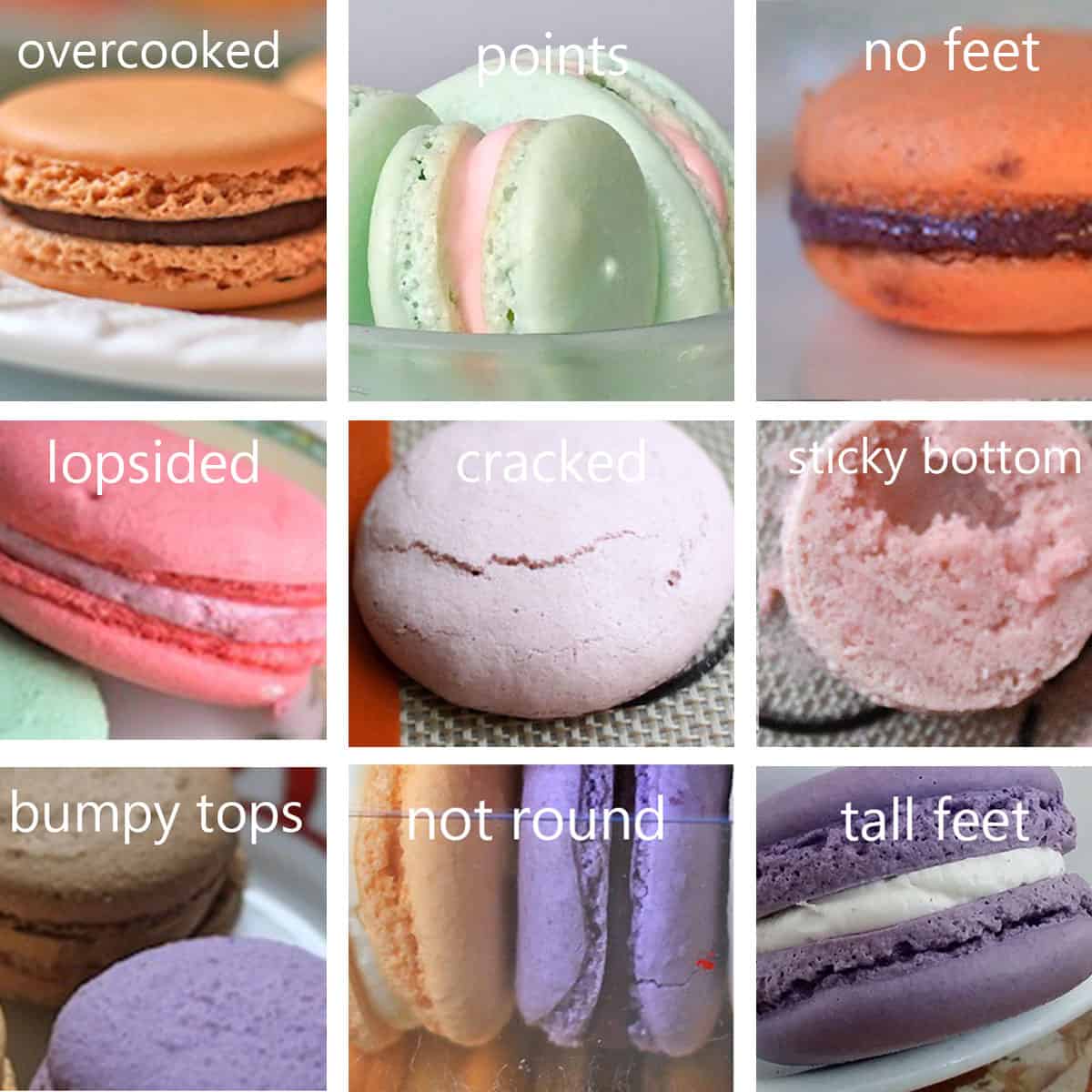
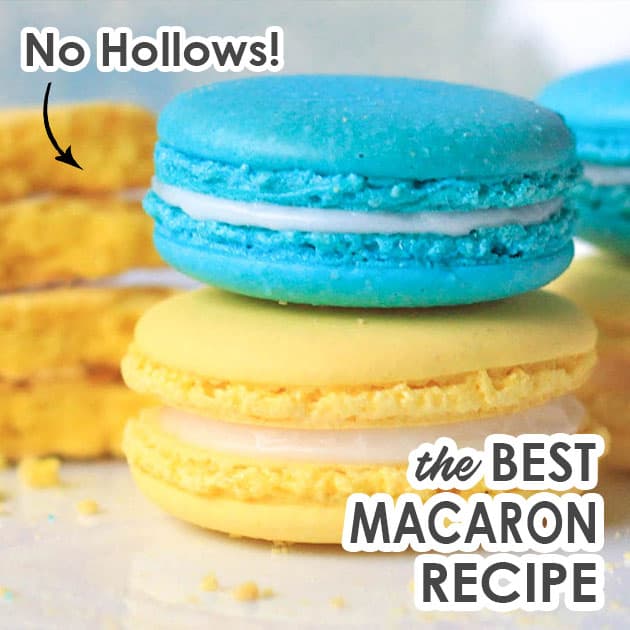

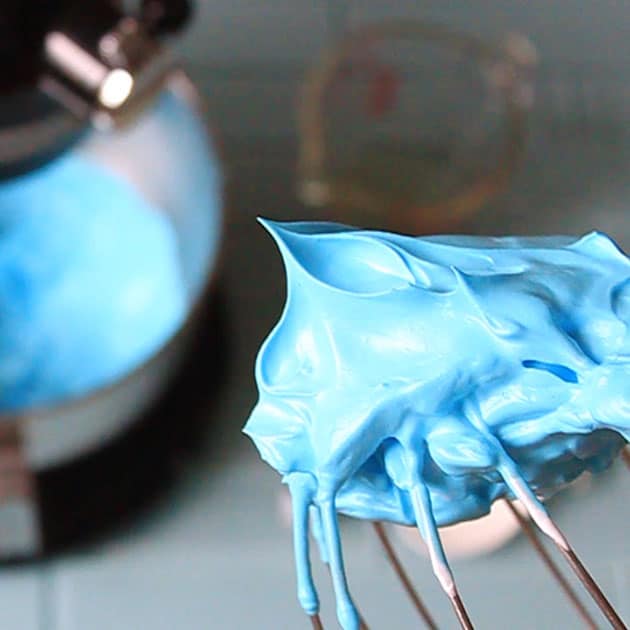
Caroline says
Hello Mimi,
My oven is a small one that can only only hold up to 37cm in length of the baking tray. I use convection baking mode and I place my rack in the middle. My oven tend to have a variance of 10 degree difference. It could never reached the temperature that I wanted after my 3rd batch of baking.
I tried baking at 140 degree celcius , but oven thermometer reads as 130. Baked at 20minutes and inside is still not cooked. I set at 150DC, my oven thermometer reached 140DC after 8-10 minutes. Baked for 18 minutes, colour is not fresh, yellowish tone and inside is fully baked but have hollow. I set at 160DC to achieve 150DC and baked for 14mins. It turn out fully baked and no hollows. Colour still oxidised.
I have used a baking tray to over the top . Colour is slightly better. But still yellowish and blotchy. My oven does not have a preheat mode. I had to set my oven to 1 hour baking time so that I can find the right temperature to put in. The moment I saw that the temperature hit 150, I put in immediately and set my own timer for 14 minutes. After when my 1 hour is up, i tried to set another 1 hour to bake for my next few batches, i can never reach the same 150DC again. I had to set to 180DC and wait for a Long time for it to reach 150 - 160 DC to bake. This can cause my macaron to be over baked or cause my macaron to be darker.
Kindly advise. I feel like throwing away my 2 year old oven.
Mimi says
Have you tried keeping a pizza stone inside the oven to help keep the temperature consistent? XOXO, Mimi
Eugene says
Hi Mimu,
Thank you for this great post. So so helpful...
Do you mean 320f with convection mode(fan on)?
I do use a convection wall oven and usually bake macarons at 300-310. But my macarons get hollow often, so stressful..... but they have perfect feet and look great.
Mimi says
Hi Eugene,
It's for regular setting without convection. If you use convection, you should calibrate it according to your own oven's instructions. Usually, you'll need 25 degrees less. Read my post on how to fix hollow macarons here.
XOXO,
Mimi
NM says
Hello Mimi! Thanks for sharing your recipe and tips! Much appreciated!
I was just wondering what you meant by: "The fully set shell was baked with oven cyclying between 300-325 F for 14 min." Do I pre-heat my oven to 325F or 300F? I have a Samsung Convection oven (not sure if it comes with fans), and I usually bake mine at 300F Convection (but oven thermometer shows 285F) for 15 minutes. They bake well but sometimes hollow. What do you recommend? Should I bake them with the convection setting or without it?
Also, whenever I bake light color macarons (especially white), they brown. What should I do? I follow a French recipe.
Mimi says
The picture caption references the bake time and temperature the macaron experienced. Most home ovens cycle up and down because the temperature is not always consistent. Once it loses its heat, the heat will increase to make up for the heat loss. I noted that my oven was hovering between these temperatures. You can also pay attention to your own oven temps like this as well since oven temps don't always hold still at one temperature.
XOXO,
Mimi
Lisa says
Hi Mimi,
I have a recipe that makes 72 cookies (36 pairs). I want to make several (6) colors of shells with this recipe. I think that this would be hard to do if I need to add the color while whipping the egg whites (it would be hard to divide the egg whites into 6 very small separate bowls and then whip them). Can I wait until the beaten egg whites have been mixed with the almond flour/confectioners sugar, divide that batter into 6 portions, and then add color to each portion. I'm using gel color.
Or is there a better way to make several different colors with one recipe?
Thanks for your help!
Mimi says
Hi Lisa,
You partly answered your own question. I do agree that it is more challenging to divide the mixed batter into 6 portions and then add the color. It is more risky because you might have to fold the batter too much to ensure the color is well incorporated. I would whip the egg whites until stiff, and then divide into 6 portions, then gently fold the gel color into the whipped whites to incorporate fully, then fold that into each of the 6 portioned almond flour, respectively. Let me know if you have any further questions.
XOXO,
Mimi
Alex Villarreal says
If I'm using a silicone mat does that require extra time cooking?
And does the Italian Method require a higher temp to form feet on silicone mat? Any advice for baking times for Italian on silicone mat. I've read these mats add like 5mins to bake time is that true. They always stick unless I over cook them
Mimi says
I actually prefer a lower temperature for the Italian method. As for silicone, it doesn't conduct heat as much as parchment paper so yes, I do agree to give it a few more minutes, use a better conducting pan (like the USA pan I have in my SHOP) or place a pizza stone on the rack below the tray.
Xoxo, Mimi
Martha says
Hi Mimi,
I'm a beginner at this but can't wait to try baking some macarons! My oven is regular size but I bake with one half sheet at a time. I do have a full sheet but it doesn't allow for even baking for some reason. Maybe not enough room around the edges for the air to circulate.
My question is: if I can only bake one sheet of macarons at a time, will it be okay to keep the batter in the piping bag? Or should I pipe it out onto another sheet and let it sit until the first batch is done?
Thank you so much!
Mimi says
Yes, you can definitely bake them one sheet at a time. I do it all the time. I recommend piping it onto the mat and then letting it rest while the other trays are baking. Try not leave the batter inside the piping bag when you are waiting.
XOXO, Mimi
Linda says
Hey Mimi, I have a new Cadco convection oven and its great! The only issue I have is that my feet arent straight. Like, ruffly. But its only ruffly on one side, the way the fan blows. Sometimes it spreads out alot too but the. Macarons are still round, its just the feet thats the problem. I use a silpat mat what do you think i can do,?
Mimi says
Have you tried looking up your issue in the Macaron Troubleshooting guide? There is an area targeted for lopsided macarons.
XOXO,
Mimi
Wendy says
Hi mimi! Just wondering, does it work with baking macarons in a Countertop Comvection oven? Or does it need a regular home oven? Hope to hear from you soon!
Mimi says
I haven't tried myself but I heard it is possible. The heating elements might be too close to the macaron though making it easier to brown. Let me know how it goes.
Mj says
If I want to make multiple colours, When is the right time to divide my mix ??? I’ve tried dividing it but it dries in me and I end up with rough looking macarons......
Mimi says
You can divide the almond into 2 parts and then make the meringue. Then divide the meringue in half using a kitchen scale to measure, then fold into each. I wouldn't recommend dividing my base recipe any further than 2 parts unless you double or triple the amount. The base recipe is so small that it is hard to divide any further without making a mistake. XOXO, Mimi
Ana says
Hi Mimi,
Could you recommend me a good oven for baking macarons?
Thanks.
Mimi says
I have baked with both convection and non-convection and found both to be equally good. I am currently using a double oven from Fridigaire Gallery and it has True European convection in both compartments. XOXO, Mimi
Mawazo SAIDI says
Hi mimi
I live in the uk and most UK Electric oven are the ones with fans, I bake my macarons at 250f for about 18 min I don’t know weather it my oven fan or the heat but I always get lopsided macarons, I have tried experimenting baking on every shelf of my oven to see if I will get a different result but I always get lopsided macarons plz plz help
Mimi says
Hi!
Your oven might not be the culprit here if you have tried and tried. You can consider not overworking your batter. There's 2 ways you can do this: don't overwhip the meringue, don't overfold. I hope it helps. XOXO, Mimi
Bee says
Hi Mimi,
Which heating element is ideal for macarons? Top ,bottom or both?
Mimi says
Every oven is different but I prefer to have more heat on the bottom and less on the top. Heating from the bottom gives more heat to the pan and it transfers to the shells to make it rise up. Too much heat from the top can cause the macarons to brown. XOXO, Mimi
Fatin says
Hi Mimi,
Whats the diameter of your macarons shell?
Whats the best size of shells that fits regular packaging
box that we could find online?
Mimi says
I usually use 1.5 inches or 1.75 inches. I am not quite sure which boxes you are looking at so I can't comment on that. Just look at the dimensions of the box you like and make sure it's bigger than what you're planning to make. XOXO, Mimi
Yuliana says
Hi Mimi,
Thank you for the post, it is indeed very useful.
I have attempted to make macaron so many times but always ended up chucking them in the bin cause always failed.
First few attempts, I never get the ‘feet’, now that I managed to get the feet, the top shell cracked and browning.
But the cookie is undercooked and very much sticky to parchment paper, I used fan-assisted home oven on 140 C degrees for 8mins
I thought the temperature is too hot, then I read everywhere ideal temperature should be around 160-180 C. Knowing 140 is too hot, I can’t imagine what 160 to 180 will be like.
Do you have any trick how to perfect it?
Thank you.
Yuliana
Mimi says
I think you might need to let the macarons bake a bit longer. 8 minutes is quite short for that temperature. (but every oven is different). Your batter might be a little "wet" too. XOXO, Mimi
Tammy says
Haloo Mimi! After reading through your article I have still a question in my head.. Do I actually adjust the heat to up&down or for only bottom one?
Mimi says
I don't quite understand your question. Do you mind explaining some more?
Beverly T says
Hi Mimi I’m not sure but I haven’t emailed with questions in a long while. Not sure who emailed you. I I hope you and the baby are doing awesome ❤️